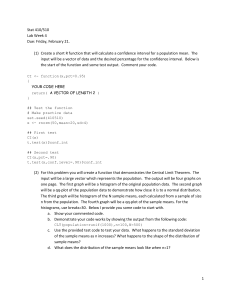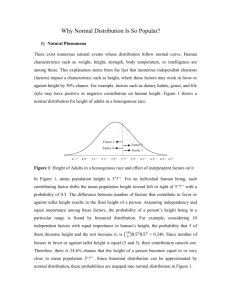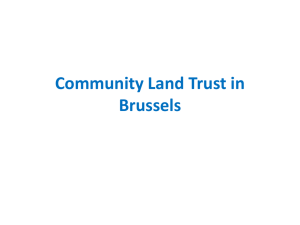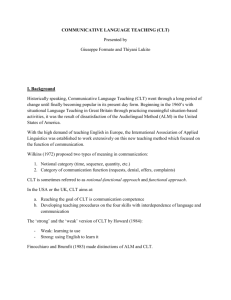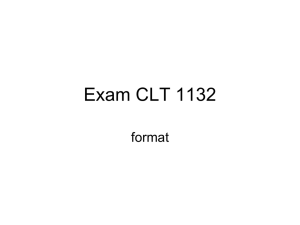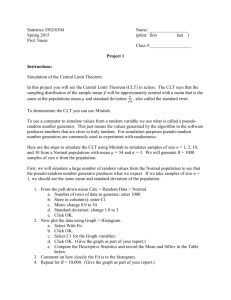UNIVERSITY OF EXETER
advertisement
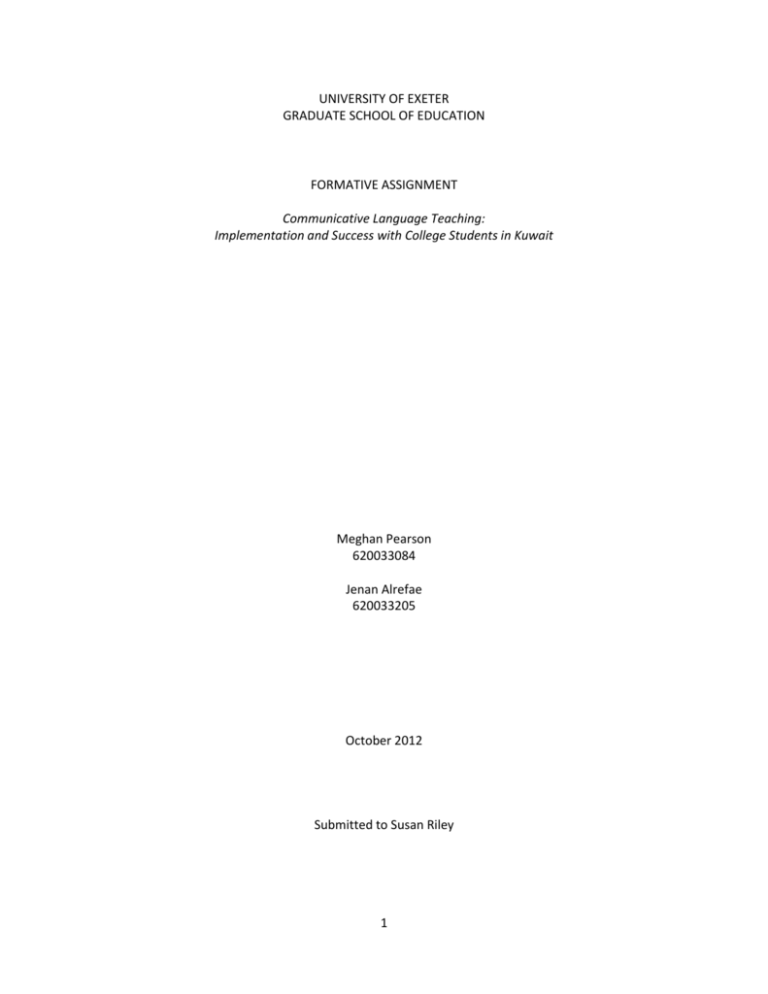
UNIVERSITY OF EXETER GRADUATE SCHOOL OF EDUCATION FORMATIVE ASSIGNMENT Communicative Language Teaching: Implementation and Success with College Students in Kuwait Meghan Pearson 620033084 Jenan Alrefae 620033205 October 2012 Submitted to Susan Riley 1 INTRODUCTION Communicative Language Teaching (CLT) is a theory of and method for second language learning. CLT seeks to combine structural and function aspects of language where the focus is on effective rather than ‘correct’ communication (Littlewood, 1995). CLT is securely situated in the context of larger paradigm shifts, specifically the shift from behaviorism to cognitivism (Jacobs & Farrell, 2003). The scope of this paper is not to provide an in-depth analysis of these theories, but rather to suggest, as others have, that this theoretical basis does provide an argument for the value of CLT in second language learning (Jacobs & Farrell, 2003). Much of the literature on CLT, while addressing issues with the approach, does admit some obvious value in focusing on the social nature and use of language to communicate (Klapper, 2003; Thompson, 1996; Littlewood, 1995). We begin by analyzing literature on theories behind, problems with, and possible improvements in the implementation of CLT. We then look the use of CLT in college classrooms in Kuwait, and address some of the issues that arise in this context. Finally, we provide suggestions for future use of CLT in Kuwait. LITERATURE REVIEW Problems with CLT Theoretical basis Klapper points out that much of the theory underpinning the CLT approach is not in fact related to language acquisition, and at best can be linked to learning of L1 (2003). Andrewes also acknowledges that CLT was developed with a narrow scope of student and context in mind; mainly students in need of “General English” studying in English-speaking countries (2005a). These criticisms suggest that it should not be surprising to find that the CLT approach is problematic when applied to a broader range of second language learners and contexts. Balancing function and structure One of the central tenets of CLT is a focus on the importance of communication and the function of language. If we consider CLT as a response to earlier teaching methods like grammar translation, this focus makes sense as reacting against the previous focus on structure. However, many argue that there is now an overemphasis on communication at the cost of understanding the language. Thompson argues that misconceptions about CLT lead to problematic situations like a complete neglect of explicit grammar instruction (1996), and Klapper agrees that one of the problems with CLT is the “embracing of a meaning based-pedagogy with little conscious attention to form” (2003). Andrewes goes on to point 2 out that when structure is neglected, students will often spend valuable class time analyzing grammar in order to increase accuracy (2005b). Misconceptions about increased work load Thompson points out that some teachers believe that taking a communicative approach expects too much from the teacher by increasing time spent preparing and assessing, and by allowing for more unpredictable lessons (1996). Andrewes claims that the teacher and the course book are the main dogma in making communicative activities in the classroom, but points out that this can be problematic for teachers working with materials that do not provide communicative activities (2005a). However, if, as Thompson (1996) and Jacobs and Farrell (2003) have suggested, teachers are not actually clear on the methodology involved in CLT, this argument could be the result of extra work required when operating within an unclear framework. Improving the use of CLT Jacobs and Farrell outline key aspects of the CLT approach and provide suggestions for the inclusion of these aspects in the language learning environment. One of these aspects is the development of learner autonomy through group work and self assessment (2003). Andrewes agrees, and points out that the integration of group and pair work hold a priority in CLT (2005a). Donato (cited in Andrewes, 2005b) reminds us that “language is actually acquired in a creative and social process within the classroom” and suggests pair, group, and whole-class activities. However, group-work can be more difficult for teachers to manage and assess, and can create a dependence on stronger students to carry the class. Finally, Jacobs and Farrell emphasizes the importance of developing thinking skills through the use of materials that develop critical thinking and assessment through open-ended questions. APPLICATION OF CLT WITH COLLEGE STUDENTS IN KUWAIT Theoretical basis Kuwaiti college students are rarely interested in “General English”, and though there are many variables that motivate their study of English, most often it is the desire to successfully complete college level courses taught in English and to receive the prestige of a degree from an English instruction school. As mentioned above, CLT theory also focuses on students learning in an English speaking country (Andrewes, 2005a), and the lack of this context for Kuwaiti college students makes it more difficult to place language in meaningful contexts related to everyday communication. It should be noted however that the use of English, at work and in everyday communication does itself carry a certain status, but 3 only a ‘token’ amount of English is needed to convey this status. The difference between college students in Kuwait and those considered in the development of CLT make it hardly surprising that the implementation of CLT can prove problematic in Kuwaiti classrooms. Balancing function and structure Though varies by institution, there has been an overall shift in Kuwait away from explicit grammar instruction. Several years ago, colleges still used grammar reference materials as course books, but in more recent years, these books have been removed from the curriculum. Course outcomes have also shifted to a focus on communication where the only structural requirement is that the language not severely impede the understanding of meaning. As Andrewes suggests, this shift has led to student fueled discussions of grammar (2005b). During high school, Kuwaiti students receive a significant amount of grammar focused practice, and the absence of this at the college level is unnerving and often demotivating. Misconceptions about increased work load As mentioned above, Andrewes points out that teachers and course books are the main source of communicative activities (2005a). This suggests, and is often the case in reality, that teachers using CLT are required to spend a significant amount of time developing activities for class. In Kuwait this is complicated when teachers are required to use older, non-communicative course books. In addition to the creation of materials, many teachers feel overwhelmed by the amount of time spent designing and marking more communicative assessments because marking requires both reading and decoding student responses. Despite this, alternative assessments can be very useful in Kuwaiti colleges as the students are usually eager to share their opinions and explain themselves, and often show deeper understanding when allowed to do so. Improving the use of CLT Jacobs and Farrell suggest that it is important to increase learner autonomy through group-work, and this is very evident in the Kuwaiti college context (2003). Many students have come from a background where they were given limited autonomy as learners, and this is reflected in their hesitancy to direct their own study and take responsibility for outcomes. Group-work does prove effective in promoting learner autonomy in a ‘safe’ environment as students can confer and rely on their classmates to assist in the learning process. 4 Jacobs and Farrell also stress the importance of developing critical thinking skills as part of the language learning process (2003). This idea has taken hold in many colleges in Kuwait as a result of students with sufficient language ability but an inability to synthesize and apply information from class. As an example, Box Hill College Kuwait added a course dedicated entirely to critical thinking, with focus directed away from ‘correct’ language use. Despite early misgivings of both teachers and students as to the effectiveness and necessity of the course, it has proved popular, and instructors teaching mainstream classes have noticed an improved ability to critically assess materials. CONCLUSION It is clear why CLT has remained such a predominant approach in second language learning. Despite problems with the use and outcomes of CLT in the classroom, small adjustments to methodology could address current issues. We have outlined several suggestions for improved use of CLT and discussed the suitability of these in the context of college students in Kuwait. One further suggestion is to consider that “English belongs to the world, as a lingua franca, and most communication in it is being carried out in situations where there are no native speakers involved” (Andrewes, 2005a, pg. 8). ‘International English’ is very apparent in Kuwait as native Arabic speakers incorporate English into their language, and the inclusion of it in the curricula would help make the study of English more relatable and useful beyond the classroom. Overall, Kuwaiti students enjoy the freedom of a communicative approach, and therefore CLT not only makes sense but is embraced by the students. 5 BIBLIOGRAPHY Andrewes, S. (2005a). The CLT Police: questioning the communicative approach. Modern English Teacher, 14/2, 5-11. Andrewes, S. (2005b). Towards a Post-Communicative Approach? Life beyond CLT. Modern English Teacher, 14/3, 4-9. Jacobs, G.M. and Farrell, T.S.C. (2003). Understanding and Implementing the CLT Paradigm. RELC Journal, 34/1, 4-30. Klapper, J. (2003). Taking communication to task? A critical review of recent trends in language teaching. Language Learning Journal, 27, 33-42. Littlewood, W. (1995). Communicative Language Teaching: An Introduction. Cambridge: CUP Thompson, G. (1996). Some misconceptions about CLT. ELT Journal, 50/1, 9-15. 6
